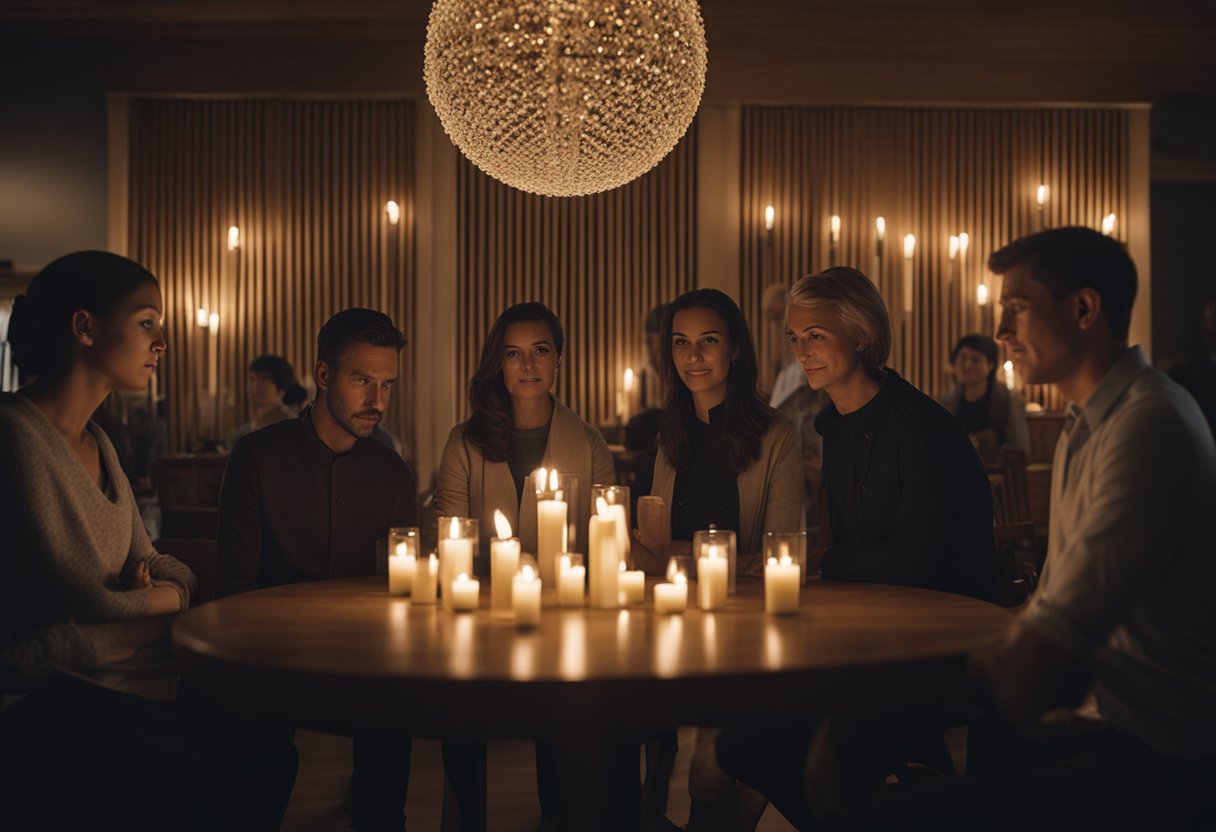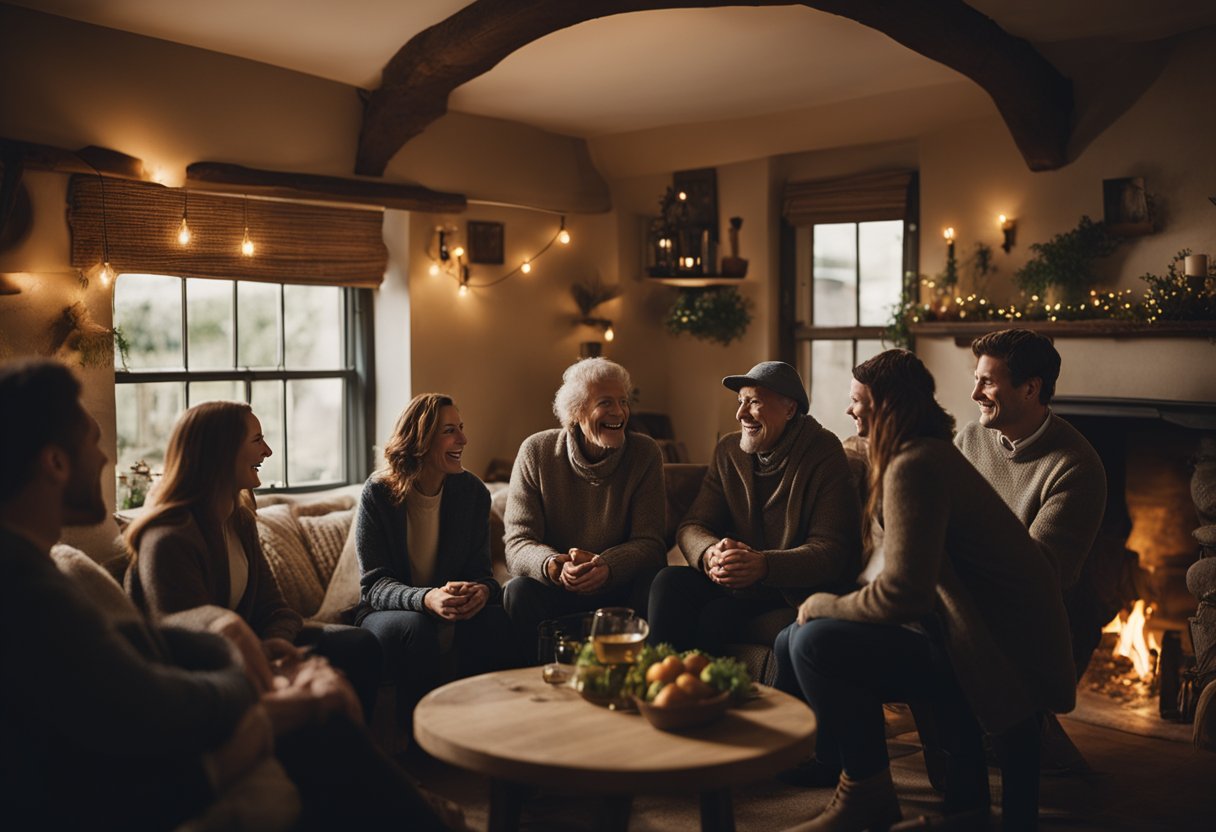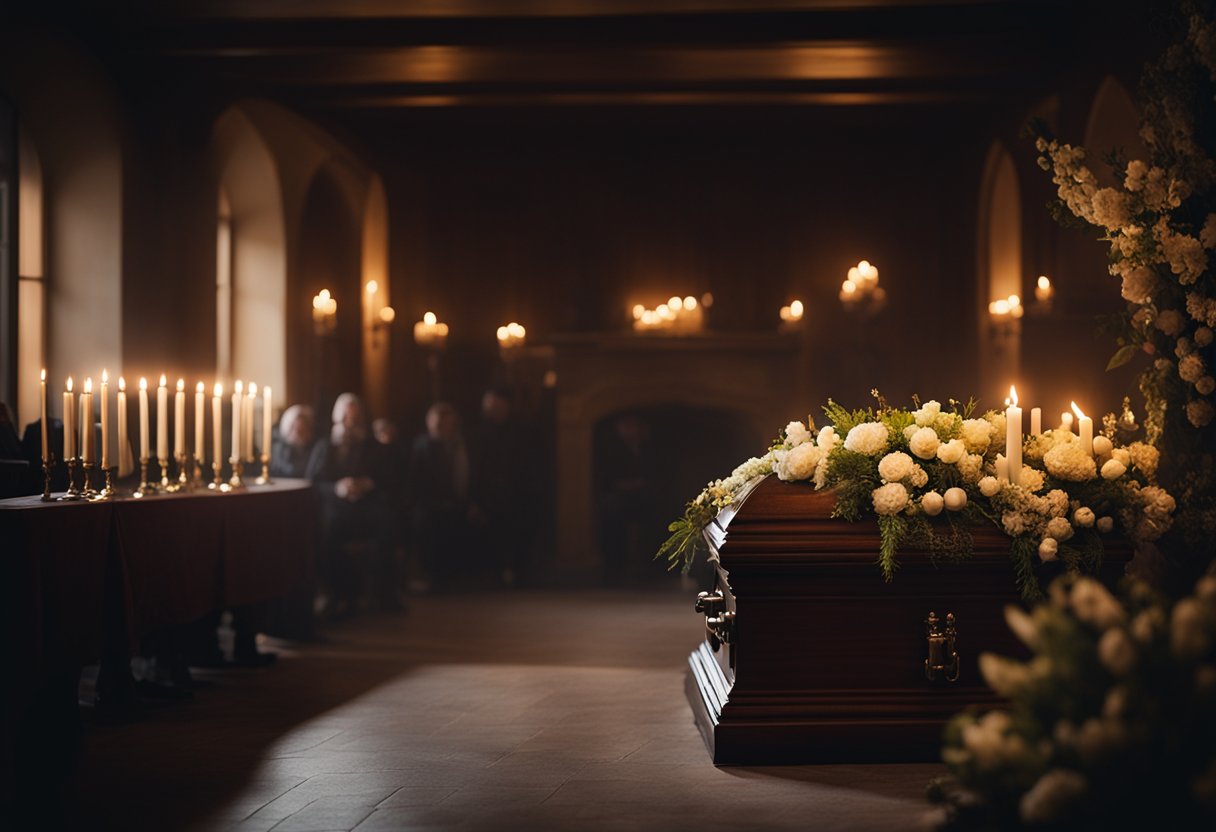The Tradition of the Irish Wake: Honoring the Departed with Age-Old Customs

Updated On: April 24, 2024 by Maha Yassin
The tradition of the Irish wake is a poignant and deeply rooted cultural practice that reflects Ireland’s complex history and approach to life and death. At its core, an Irish wake is a send-off for the deceased that balances mourning with celebration, encapsulating the Irish spirit in commemorating a life. These wakes historically serve as a farewell that involves a combination of rituals, social elements, and cultural significance, underscoring the community’s role in the grieving process.
Over time, the wake has maintained relevance by adapting to modern contexts while preserving its traditional essence. As we gather around the departed, the wake encompasses storytelling, music, and shared remembrances intrinsic to Irish culture. Both a reflection on the past and a living part of Ireland’s cultural expression, the Irish Wake weaves together the threads of tradition, social support, and collective memory, ensuring that the customs surrounding death are as much about life as they are about the inevitable end.
Historical Context

The Irish wake is a practice steeped in history, reflecting ancient customs and the evolution of Irish society through periods of colonization and poverty.
Origins and Evolution
The custom of the Irish wake has its roots in ancient Celtic traditions and has transformed over centuries to incorporate Christian elements. Originating from the ancient Celts, wakes were significant as part of their belief system centred around death and rebirth. These rituals allowed the community to honour the departed and protect them from evil spirits on their journey to the afterlife. As Christianity spread through Ireland, these pagan rituals were amalgamated with Christian practices, particularly the Catholic faith. This led to the modern wake’s unique blend of sombre reflection and celebration of life.
Ancient Practices
Ancient Celts: The Irish wake holds many customs that are a testament to the beliefs of the ancient Celts. They maintained a staunch belief in the soul’s immortality and the importance of aiding its passage to the Otherworld. This is evident in the tradition of keening, a form of vocal lament for the dead, performed by women known as “bean chaointe.”
Irish Customs: Understanding the socio-economic context is crucial, as poverty often shaped funeral customs. During times when traditional burial practices could be a financial strain, community-driven wakes ensured that all could afford to honour their dead with dignity. This collective aspect underscored the significance of the wake as a unifying force within Irish communities, forging a sense of kinship and shared identity even in the hardest times.
Our wake traditions today are influenced by this history, evolving across generations to become what we recognise now as a defining aspect of Irish heritage.
Ceremonial Process

The Irish wake is a significant funeral tradition, rooted deeply in our cultural heritage. Its ceremonial aspects reflect our collective respect and affection for the deceased.
Preparation of the Deceased
Initial Steps: We carefully wash and dress the body in the deceased’s clothes, which is a practice signifying our respect for their earthly journey. Once prepared, the body is laid out in an open casket, typically in the family home.
Setting: The room where the deceased is laid out is arranged with candles to signify the presence of the spirit and a rosary entwined in their hands, symbolising our prayers for their soul.
Vigil and Prayers
Gathering and Vigil: Throughout the wake, we maintain a continuous vigil by the deceased’s side, a practice that ensures they are not alone on this transitional passage. It’s common for this vigil to continue through the nighttime, marked by a solemn yet communal atmosphere.
Rosary and Reflection: The recitation of the rosary is a central spiritual component, involving family and friends in prayerful reflection. Other prayers may be offered, and personal anecdotes about the deceased are shared, intertwining grief with the celebration of their life.
Cultural Significance
In exploring the tradition of the Irish wake, we uncover its deep roots in Irish culture, offering a profound understanding of how the community comes together in times of death and mourning.
Symbolism of Death and Mourning
The Irish wake is a poignant emblem of Irish culture’s approach to death, blending both tradition and respect for the deceased. It signifies a passage not only for the departed’s soul but also serves as a rite for those who grieve. The wake is a communal space that provides a structured environment for expressing sorrow and often includes traditional elements such as the recitation of the Rosary, which showcases the influence of Catholicism on Irish customs.
Community and Support
Integral to the wake is the sense of community, a time when friends and relatives gather to lend support. This solidarity is crucial in the grieving process and underscores the Irish wake’s role as a communal coping mechanism. The collective presence of loved ones and sharing stories about the deceased bond the community and reaffirm the social support network.
Throughout this observance, there is an implicit recognition of the importance of unity in coping with loss, echoing the ethos that has long been a cornerstone in Irish culture and mourning practices.
Wake Practices
The wake holds a special place in the rich tapestry of Irish funeral traditions, bringing together complex customs and a warm sense of community. We’ll explore the specific practices that define an Irish wake, focusing on keening and providing refreshments.
Keening and Grieving Customs
Keening, a traditional form of vocal lamentation for the dead, is a poignant expression of grief during an Irish wake. The sound of wailing, often led by women known as “bean chaointe” or keening women, underpins the ritualistic sharing of sorrow and remembrance. These customs serve a dual purpose: honouring the departed and allowing mourners to express their feelings openly.
Food and Beverage Offerings
Food and drink are central to the convivial atmosphere at a wake. Tables are typically laden with an array of offerings, from sandwiches and cakes to reflect the communal nature of the gathering, ensuring sustenance for those who’ve travelled to pay their respects.
- Tea: A staple of any Irish social occasion, served continuously.
- Alcohol: Often present in whiskey or “a wee dram,” it’s pivotal in toasting the deceased.
- Cakes: Brought by visitors, they represent the circle of life and the continuance of community ties.
Thus, through keening and the communal sharing of food and drink, Irish wakes create a space for mourning and celebration of a life well-lived.
Social Elements
In an Irish wake, the collective spirit of remembrance is marked by vibrant social activities that embody Irish communal life’s unique character. Central to this are storytelling and songs that serve as a tribute, as well as the games and merriment that celebrate the departed’s life.
Storytelling and Songs
We often see an Irish wake becoming an intimate stage where stories and songs are shared, echoing the lived experiences of the dearly departed. These accounts range from humorous to heartfelt, with each narrative thread capturing a facet of the person’s life. Irish wake songs are especially meaningful, combining music and lyrics that resonate with collective memories and emotions.
Games and Merriment
Despite the sombre occasion, merriment has its place in this time-honoured tradition. Games play a pivotal role in an Irish wake, lightening the mood and often bringing laughter amidst the grief. Such activities serve a dual purpose: they honour the lighter side of the deceased’s life and provide solace through shared camaraderie.
Spatial and Temporal Settings

In the tradition of the Irish wake, the home and the passage of time play crucial roles. Our exploration captures the essence of the sacred space where family and friends gather, and the specific duration that shapes this profound cultural practice.
The Home as a Sacred Space
The deceased’s home transforms into a sacred space, a central hub where the wake occurs. It’s more than just a setting; it’s a place where a blend of sorrow and celebration coexists. The furnishings of a house are rearranged to create an area for the open casket to rest, anchoring the proceedings. This space allows the deceased to be honoured, and people can express their grief and offer support.
Timing and Duration of the Wake
Traditionally, a wake lasts for around three days, often beginning immediately after death. The timing is significant as it represents an interim pause where the community can reflect and pay respects. It includes the night, a time considered especially poignant, with communities staying up to watch over the deceased, involving storytelling, prayer, and song. Through the night and into the day, the wake’s duration allows ample time for people far and wide to visit the home and say their farewells.
Modern Adaptations

As we witness the evolution of Irish wake customs, contemporary practices blend traditional elements and modern adaptations. This transformation includes changes in the setting of wakes and the incorporation of customs from Irish communities abroad.
Contemporary Wakes
Modern Irish wakes often take place in funeral homes rather than at home. This shift allows for professional handling of logistic and practical arrangements, offering families a supportive environment during personal reflection and remembrance. Moreover, adaptation to contemporary lifestyles means that wakes may now be shorter, sometimes spanning just a single day, making it easier for friends and extended family to pay their respects without necessitating a lengthy commitment.
Influences from Abroad
In countries like the United States, where there is a significant Irish-American community, wakes often incorporate Irish traditions with local practices. This has resulted in a unique blend, with elements like the Irish wake’s communal aspect retained while embracing American funeral customs. The dialogue between Irish tradition and foreign influences has led to a rich intercultural exchange, fostering deeper connections among the global Irish diaspora and bringing innovative ways to honour the departed.
Rituals and Etiquette
In the time-honoured tradition of an Irish wake, guests gather to pay their respects and honour the deceased. Proper etiquette and rituals are observed to ensure a respectful and dignified farewell.
Viewing and Dress Code
Viewing: During the wake, the deceased is typically laid out in an open coffin for visitors to view and pay their last respects. This takes place in the home of the deceased or a relative’s house, often in a room set aside for quiet contemplation. Attendees must approach this sombre event with the utmost respect.
Dress Code: The dress code for an Irish wake can vary, but traditionally, mourners dress conservatively, with men often wearing suits and women in subdued attire. Bright colours are generally avoided out of respect for the family.
Hosting and Guest Behaviour
Hosting: As hosts, it is our responsibility to create a welcoming atmosphere for those who come to grieve. This involves offering food and drink and ensuring a comfortable environment that accommodates the guests’ needs.
Guest Behaviour: Guests are expected to conduct themselves with decorum, sharing stories and offering condolences. It is important to balance sorrow and celebration of life, adhering to both spoken and unspoken etiquette. It’s a time for reverence, fond memories, and support.
Variations and Personalisation
The rich tapestry of the Irish wake is woven with regional customs and individual choices, each bringing a unique hue to the celebration of life.
Regional Differences
Regional customs can significantly influence how an Irish wake is conducted. For example, in some parts of Ireland, it’s common to see the deceased’s body kept at home for several days before the funeral, allowing community members to visit and pay their respects. Covering mirrors, which may be more prevalent in rural areas, reflects an old belief to prevent the deceased’s spirit from getting trapped. In contrast, urban wakes could adopt more modern practices while honouring the underlying traditions.
Individual Preferences
Personal touches are a cornerstone of the wake, as they tailor the ceremony to the individual. Families might choose to display photographs, favourite books, or items that reflect the deceased’s interests. The decision to play specific music or have particular readings can turn the wake into a heartfelt tribute, often characterised by sorrow for the loss and a celebration of the person’s life. Each wake thus becomes a personalised remembrance, moulding ancient customs to create a singular final farewell.
Life, Death, and Remembrance
In the Irish tradition, wakes play a pivotal role in celebrating a person’s life, honouring their memory, and offering a space for reflection on their legacy.
The Role of Memory
The Irish wake is a testament to a person’s indelible mark on their community. During these gatherings, memories of the deceased are shared amongst family and friends, with tales rich in emotion and heritage. Each recollection at a wake serves as a comfort to the bereaved and a crucial act of remembrance. It’s a way to ensure that a person’s legacy lives on, woven into the fabric of community and kinship.
Reflections on Legacy
Through the lens of the wake, we contemplate our legacy and the echoes we shall leave behind. This tradition encourages us to ponder on life after death, not in a metaphysical sense, but in the continuation of our stories and the impact of our deeds on future generations. To honour these reflections, life is celebrated; food, stories, music, and the collective embrace of those gathered help to solidify and express lasting respect for the legacy of the one who has passed.

Conclusion
In reflecting on the Irish wake, one observes a tradition steeped in cultural significance. These gatherings retain a deep sense of community and mourning, illustrating a unique approach to saying goodbye. Despite evolving societal norms, the essential components of these wakes—family, friends, and the collective sharing of grief and celebration—remain intact.
Our final thoughts suggest that as long as there is respect for heritage and an appreciation for meaningful rituals, the future of Irish wakes remains secure. This practice honours the deceased with a blend of sorrow and joyous remembrance, demonstrating resilience in the face of change.
With their rich tapestry of customs, Irish wakes continue to be a testament to the enduring power of tradition. As the world progresses, these rites provide a vital link to the past, ensuring that the essence of Irish culture is preserved for future generations.
- Summary: The Irish wake is a poignant celebration of life and a testament to the enduring nature of Irish traditions.
- Reflection: It fosters communal support and embodies the nation’s spirit in the face of loss.
- Future: Adaptation and respect for tradition may see this custom persist in the evolving culture.
Our collective journey through acknowledging and understanding such rites enhances our appreciation of diverse cultural practices. Through these explorations, we continue to connect, honouring those who have passed and, in turn, enriching our sense of identity and community.
Frequently Asked Questions
In this section, we address people’s common inquiries regarding Irish wakes, focusing on aspects such as attire, beverages, duration, food, gifts, and contemporary practices.
What is the appropriate attire for attending an Irish wake?
Traditional Irish wakes call for attendees to wear respectful and conservative clothing, often leaning towards dark or sombre colours. It’s our way to show reverence and respect for the deceased and their family.
How is drinking typically incorporated into an Irish wake?
Alcohol serves as a social lubricant at many Irish wakes, with drinks often shared in remembrance of the deceased. It’s not uncommon for whiskey or a ‘wee dram’ to be offered, symbolising a toast to the life that has passed.
What is the duration of a traditional Irish wake?
A traditional Irish wake typically spans a couple of days, allowing community members to pay their respects. This time-honoured practice reflects our belief in the importance of giving ample time to mourn and celebrate the life of a loved one.
What type of food is customarily served at an Irish wake?
Food served at an Irish wake usually consists of simple, comforting fare such as sandwiches, cakes, and tea. These offerings are a token of hospitality, ensuring that all who come to mourn are sustained and welcomed.
What are common gifts to bring to an Irish wake?
Bringing a sympathy card or a simple floral arrangement is common at Irish wakes. These tokens express our condolences and support for the grieving family.
What are the customary practices at an Irish wake today?
Today, Irish wakes retain many traditional elements, with the deceased usually laid out at home, surrounded by candles and attended by family and visitors. Prayers and songs remain integral to our mourning, reflecting our cultural and religious heritage.






